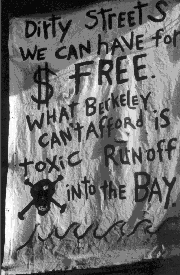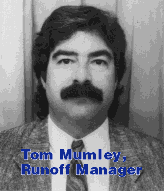To Sweep
Or Not To Sweep...
The question is whether municipal 'opt-out' programs compromise the EPA's Clean Water Act.
The cities of Oakland and Berkeley, California, have adopted street cleaning programs which would seem to have a contradictory component given the EPA Clean Water Act's stormwater mandate: In some areas of these cities, citizens have been allowed to 'opt-out' of having their streets cleaned.

Given the EPA's Clean Water Act mandate, concerns have surfaced that these streets might not actually be getting cleaned. Our article information gathering found a fairly widespread perception that residents are doing nothing, or at best are just picking up the large debris. It seems questionable whether the 'fines' (as defined by the EPA), which studies have shown hold the largest concentrations of heavy metals and other problem particulates, are not being removed except via stormwater runoff.
According to Al Lenzini, Deputy Director of Public Works and manager of Oakland's street sweeping program, about 200 of that city's 3,846 total streets are currently, in theory, being swept by residents. Oakland's opt-out program was first started in 1987, when a group of residents fought against scheduled street sweeping, primarily because of the city's newly instituted program requiring car removal on sweeping days. As an alternative, these residents said that they would keep the streets clean themselves.
In response, Oakland enacted a policy stating that if 80% of the people living on a given street would sign a petition agreeing to keep their street clean themselves, then sweeping - and the controlled parking that goes with it - would be halted. Residents of about 100 streets mounted successful petition drives, and their streets have not been visited by a mechanical sweeper since then. An additional 100 streets have been added to the list under a more recent, slightly modified program last year.

Berkeley resident L.A. Wood is an activist on the topic of stormwater runoff, and an outspoken critic of the Oakland and Berkeley opt-out programs.
"Street sweeping has been practiced in this area since the horse and carriage days, but it is no longer just litter control," says Wood. "Today's street-borne pollutants include some of the metals and petroleum by-products associated with vehicles and road surface sediments.
"In 1987, Oakland's street sweeping program was theoretically updated to include the removal of toxic pollutants that collect on city streets. This failure by Oakland and Berkeley to sweep all of their accessible residential streets, however, is challenging the integrity of the entire county's stormwater runoff program. It also contributes significantly, and unnecessarily, to the pollution stream entering San Francisco bay. There has been no review since the Clean Water Act became law. No municipalities with the urban densities of Oakland and Berkeley should have an 'opt-out' program. The majority of opt-out streets also seem to be clustered in the more affluent sections of these towns. These aren't residents who are excited about keeping their streets clean. They are, rather, people who don't want to worry about getting tickets for not moving their cars. Because of opt-out, Berkeley actually is sweeping fewer streets now than in past years. How can this be progress?"

"I would like to sweep every street in Berkeley," responds Vicki Elmer, Public Works Manager for Berkeley. "Although we both have opt-out streets, Oakland and Berkeley are also the only two cities in Alameda County with mandatory sweeping days, and enforced parking programs. The other cities in our county sweep around their parked cars. So, in some ways, we are really hard-nosed with our street sweeping programs.
"Also, we have streets in the hills without curbs and gutters, and can't sweep there. That's a problem we don't know what to do about, because we are really quite concerned with the urban runoff, and heavy metals going into the bay. We're committed to doing what we can, environmentally, to make our bay safe."
Are measurements taken to determine whether or not the streets that have been opted-out are actually being swept? "In our streets," said Lenzini, "we are looking at the amount of visible litter and debris. No, we have not pulled any streets off the program. Those particular streets that have petitioned know that they have the requirement of keeping their streets clean. They can go out with their brooms on Saturday mornings, or whenever they are off, and sweep the areas and get them clean."
Responds Wood, "Today sweeping is recognized by the EPA as a Best Management Practice (BMP) in developing a strategy to control non-point source pollution. How can you measure the effectiveness of street sweeping if you don't do a complete sweep of the city? Both Oakland and Berkeley will tell you that they can't sweep hills, but both, in fact, sweep select areas of their hills.
"It is the simple idea that urban city streets contain more than just litter that has helped to shape our federal runoff program. For a street to just look clean is no longer enough. To be truly effective, monitoring now must be directed at numerical water quality standards, not a drive-by appraisal.
"Only a program of measurement can provide an understanding of the source of runoff pollutants, their varied content, and the value of our designated clean water activities such as street cleaning. Even if a city resists implementation of numerical effluent limits, however, in favor of the BMP approach as a means of monitoring and controlling urban runoff, there is no place for an opt-out program. There is no BMP that can withstand scrutiny unless all accessible urban roadways are being swept."
Berkeley recently stopped allowing new opt-out streets to enter the program, although previously opted-out streets are unaffected. In the city of Oakland the opt-out program is still ongoing. We will keep monitoring this topic, and provide an update next issue.

We still don't know how to sweep effectively for 'fines.'
We invited the San Francisco Bay Regional Water Quality Control Board, the state's water pollution control authority for the bay area, to provide comments on the opt-out program. Tom Mumley, their Urban Runoff Control Manager, wrote the following article on that topic, and included as well that organization's current view on street sweeping as a best management practice of the Clean Water Act.
From our perspective, the jury is still out as to whether street sweeping is truly a stormwater best management practice. Most street sweeping is currently done for its aesthetic value and litter control, and is not operated in such a way as to get the 'fines,' the small particles where we expect the toxic pollutants to be.
We would like to consider street sweeping to be an effective stormwater pollutant control measure. However, there are still many questions about current sweeping practices and improved practices that must be answered before this determination can be made. My observations are that most street sweepers are operated at a speed way too high to be functional relative to small particles and toxic pollutants.
As I recall, the studies done during the Nationwide Urban Runoff Program concluded that to be effective, street sweepers, whether broom or vacuum, would have to be operated at about 4 or 5 mph. I've never seen a sweeper go that slow in my life. The question is not necessarily whether the opt-out program, in and of itself, is bad. It's more a matter of getting to the heart of what we can do for better management of runoff, through improved performance of street sweeping. Until we truly answer that question, we can't really answer the question of opt-out.
For all we know, the opt-out program could actually be more effective, if people actually followed through by getting out there and sweeping the streets by hand. By doing so they might, indeed, get the smaller particles.
There are indications that a significant source of copper may be coming from brake pad wear. If that is the case, then it's accumulating in the dust on the roadways, and it probably tends to be in fine particles. So, clearly, the question that is out there is "Is street sweeping an effective means of dealing with copper associated with automobile brake pad wear?" That question is certainly being asked by us, because of our concern about copper levels in the bay, but we don't have hard data on what street sweepers can really do about this.
We simply need more data, and to me it's amazing how little information is out there for an industry that's so big. We're talking about machines that cost $100,000 and up, being used by cities throughout the country. All of the large cities are now expected to do stormwater management. There is really a role for the industry to play in getting this information out, developing the studies that are needed, etc. What we're running into is a reluctance to change. We're dealing with city maintenance folks who are used to one type of sweeper, sweeping in a particular manner, whether requiring parked cars to be moved or not, and they don't like to change.
A valid argument might be that vacuum sweepers can pick up more 'fines' than mechanical broom sweepers, but the response will be, "Who says they're better, that's hearsay." It may seem logical, but there isn't sufficient empirical data to truly justify any type of change. We simply need better data and, until then, the issue of opt-out relative to stormwater quality will remain pretty much a moot point.
Our regulatory approach to stormwater management in California, at least in the early days, is to not mandate any particular measure until it has been demonstrated that the measure is indeed effective. Also, even if a particular control measure, or Best Management Practice (BMP), is effective, we would always allow for an equivalent alternative. So, we would say, "Okay, if you can remove a certain amount of pollutants from the streets with effective street sweeping, then that is the performance standard to be met." At that point, an opt-out program could be offered which would require that anyone doing their own sweeping would have to meet that standard. Without a performance standard in place, however, the whole issue can be argued to death.
Street sweeping, in and of itself, is not a solution unless it is done right; in such a way as to make the impact that needs to be made. In this, parked cars become a big issue, because if you can't get to the curb you've lost the opportunity to get to where the pollutants accumulate.
Along with that, we are concerned about the issues related to proper waste management. We need to figure out how to classify the waste that is picked up, then take care of it correctly. There is a video that L.A. Wood took of activities at a municipal corporation yard showing that the municipal sweepers being operated by a city were being washed out directly over a storm drain inlet. This is clearly not appropriate, but what, on the other hand, is? There are so many questions about how to handle municipal waste: should it be classified as something out of the ordinary, if so, what type of waste; can we manage it in such a way as to distinguish some types of it from others; what can be gained by screening in terms of discriminating between qualities of wastes? Perhaps regionalization of waste collection would allow the truly nasty waste to be dealt with, and at the same time legitimize what may be many uses for the relatively good stuff.
These are complex issues that need some serious untangling. We all need to work together to find solutions to these difficult problems.
This article is reprinted from American Sweeper magazine, v3n3.
|